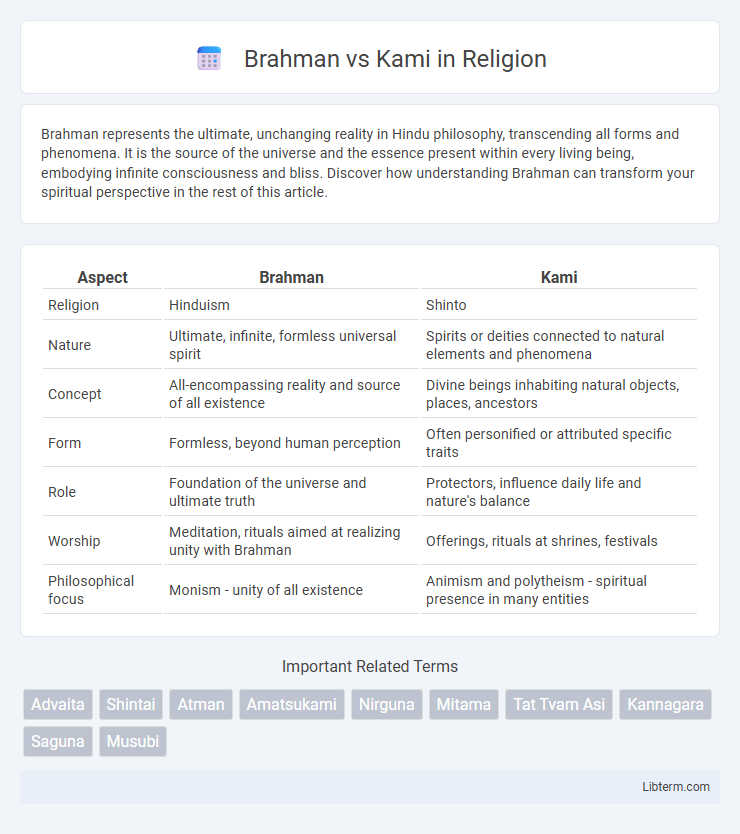Brahman represents the ultimate, unchanging reality in Hindu philosophy, transcending all forms and phenomena. It is the source of the universe and the essence present within every living being, embodying infinite consciousness and bliss. Discover how understanding Brahman can transform your spiritual perspective in the rest of this article.
Table of Comparison
| Aspect | Brahman | Kami |
|---|---|---|
| Religion | Hinduism | Shinto |
| Nature | Ultimate, infinite, formless universal spirit | Spirits or deities connected to natural elements and phenomena |
| Concept | All-encompassing reality and source of all existence | Divine beings inhabiting natural objects, places, ancestors |
| Form | Formless, beyond human perception | Often personified or attributed specific traits |
| Role | Foundation of the universe and ultimate truth | Protectors, influence daily life and nature's balance |
| Worship | Meditation, rituals aimed at realizing unity with Brahman | Offerings, rituals at shrines, festivals |
| Philosophical focus | Monism - unity of all existence | Animism and polytheism - spiritual presence in many entities |
Introduction to Brahman and Kami
Brahman in Hinduism represents the ultimate, unchanging reality, embodying infinite consciousness and the source of all existence, often described as formless and beyond human perception. Kami in Shintoism are spirits or phenomena that inhabit natural elements like trees, rivers, and mountains, reflecting a belief system deeply connected to nature and ancestral reverence. Both concepts highlight core spiritual beliefs, with Brahman emphasizing universal oneness and Kami focusing on the sacredness within the natural world.
Origins: Hinduism and Shinto Beliefs
Brahman in Hinduism represents the ultimate, unchanging reality, originating from ancient Vedic traditions as the universal soul that pervades all existence. Kami in Shinto are spirits or phenomena embodying elements of nature, ancestors, and sacred spaces, rooted in Japan's indigenous animistic beliefs. Both concepts emphasize a connection to the divine essence, with Brahman symbolizing metaphysical oneness and Kami reflecting localized spiritual manifestations.
Defining Brahman: The Ultimate Reality in Hinduism
Brahman in Hinduism represents the ultimate reality, an infinite, unchanging cosmic principle that transcends all forms and phenomena. It is the source of the universe, embodying pure consciousness and existence beyond human perception, unlike Kami in Shinto, which are spirits or deities associated with natural elements and ancestors. Understanding Brahman involves recognizing it as the singular divine essence underlying all diversity, central to spiritual teachings and practices in Hindu philosophy.
Understanding Kami: Spirits in Shinto Tradition
Kami in Shinto tradition are divine spirits or phenomena that embody natural elements, ancestors, and sacred places, reflecting the interconnectedness of the natural and spiritual worlds. These spirits possess distinct personalities and powers, influencing human life through blessings or warnings, with rituals aimed at maintaining harmony between humans and kami. Unlike the singular, formless Brahman in Hindu philosophy, kami are numerous, tangible entities worshipped through offerings, festivals, and shrine visits to honor their presence and ensure communal well-being.
Philosophical Differences: Monism vs. Animism
Brahman in Hindu philosophy represents an ultimate, infinite reality characterized by monism, where all existence is unified as a single, universal consciousness beyond individual forms. In contrast, Kami in Shinto belief embodies animism, recognizing numerous distinct spirits or deities inhabiting natural elements and objects, each with its own identity and agency. The fundamental difference lies in Brahman's abstract, formless unity compared to Kami's personalized, pluralistic spirit presence within the natural world.
Role in Religious Practices and Rituals
Brahman in Hinduism represents the ultimate, formless reality and is central to meditation, chanting of mantras, and rituals that seek union with the divine essence. Kami in Shinto are spirits or deities tied to natural elements, ancestors, and sacred places, with rituals emphasizing purification, offerings, and festivals to honor and appease them. Both serve as focal points for worship, but Brahman symbolizes an abstract cosmic principle while Kami embodies tangible spiritual forces connected to everyday life.
Representation in Sacred Texts and Narratives
Brahman in Hindu sacred texts like the Upanishads is depicted as the ultimate, formless reality underlying all existence, transcending personal attributes and conceptualization. In contrast, Kami in Shinto texts such as the Kojiki and Nihon Shoki are described as diverse spirits or deities embodying natural phenomena, ancestral beings, and cultural values, often represented with distinct personalities and stories. While Brahman represents an abstract metaphysical principle beyond narrative, Kami are embedded within rich mythological narratives emphasizing their interaction with the natural and human worlds.
Influence on Culture and Art
Brahman, as the ultimate reality in Hinduism, profoundly shapes Indian culture and art through its concepts of unity, divinity, and cosmic order, inspiring classical dance, temple architecture, and spiritual literature. In contrast, Kami in Shintoism embodies nature spirits that influence Japanese culture by fostering reverence for natural elements, leading to traditional practices like shrine rituals, woodblock prints, and garden design. Both Brahman and Kami serve as foundational symbols, deeply embedded in their respective cultural expressions and artistic heritage.
Comparative Spiritual Significance
Brahman in Hinduism represents the ultimate, unchanging reality, embodying absolute consciousness and cosmic unity, whereas Kami in Shinto refers to divine spirits or phenomena that inhabit natural elements and ancestral entities. Brahman's spiritual significance lies in its transcendental nature, serving as the foundational principle for existence and liberation (moksha), while Kami emphasizes a tangible connection between humans and the environment, fostering harmony and reverence within everyday life. Both concepts shape their respective religious practices by directing followers toward understanding the sacred, yet Brahman focuses on metaphysical oneness and universal truth, whereas Kami highlights localized, spiritual presence in nature.
Conclusion: Bridging Eastern Spiritual Concepts
Brahman and Kami represent foundational spiritual entities in Hinduism and Shinto, respectively, each embodying the essence of divinity and universal presence. Understanding these concepts highlights the shared emphasis on all-encompassing sacred forces within Eastern religions, fostering a deeper appreciation of their philosophical intersections. Bridging Brahman's abstract, formless nature with Kami's more personalized and nature-centric essence reveals complementary perspectives on spirituality and the divine.
Brahman Infographic

 libterm.com
libterm.com